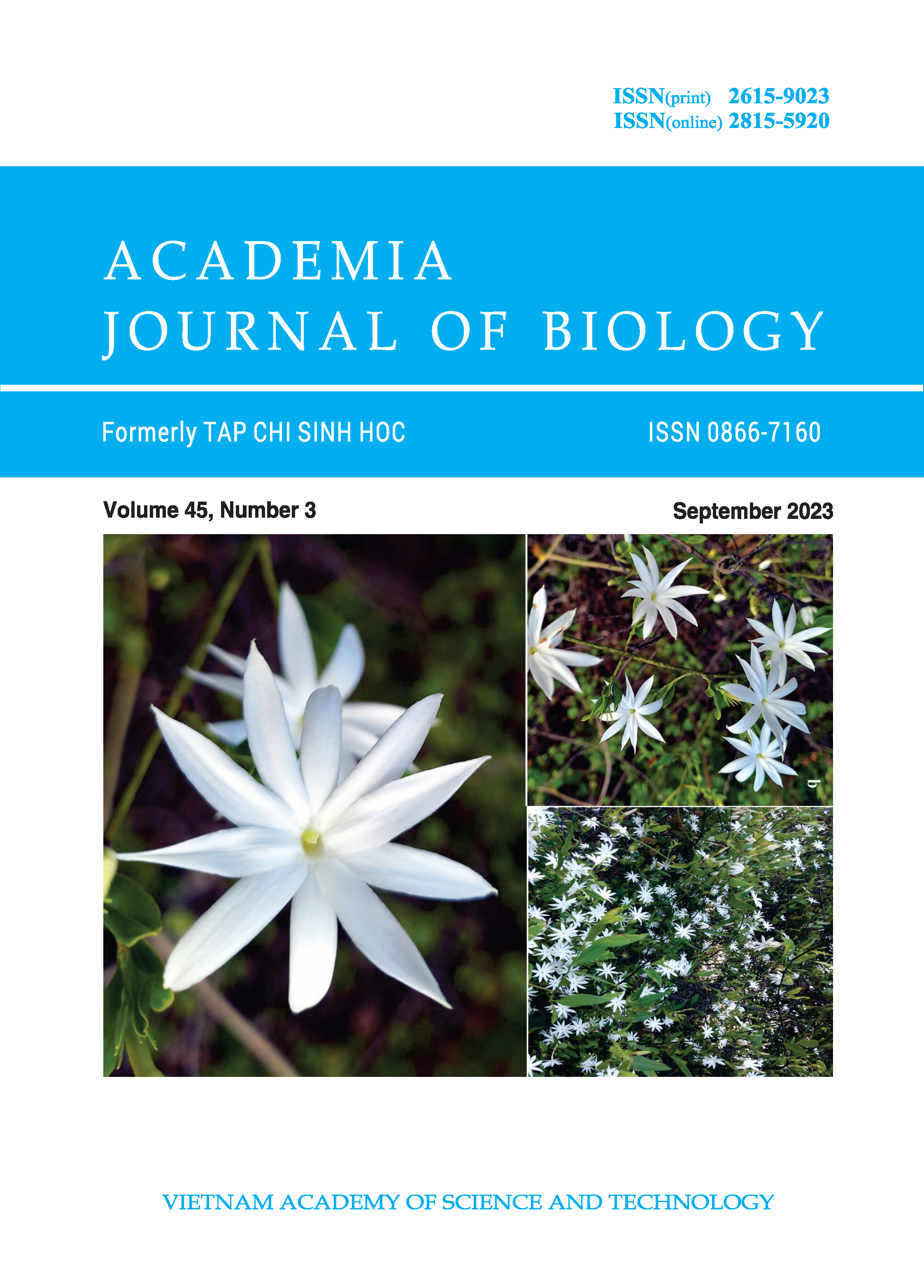Remarks on the diversity and echolocation calls of hipposiderid bats (Chirroptera: Hipposideridae) in Cuc Phuong National Park, northeastern Vietnam
Authors
DOI: https://doi.org/10.15625/2615-9023/19228Keywords:
Echolocation, ecology, identification, monitoring, morphology.References
Bates P. J. J., Harrison D. L., Jenskins P. D., Walston J. L., 1997. Three rare species of Pipistrellus (Chiroptera: Vespertilionidae) new to Vietnam. Acta Zool. Acad. Scient. Hung., 43: 359–374.
Bates P. J. J., Hendrichsen J. L., Walston J. L., Hayes B., 1999. A review of mouse-eared bats (Chiroptera: Vespertilionidae: Myotis) from Vietnam and results of a recent survey. Acta Chiropterologica, 1: 47–74.
BIIP (BirdLife International - Indochina Programme), 2001. Sourcebook of Existing and Proposed Protected Areas in Vietnam: Cuc Phuong National Park, pp. 6.
Borissenko A. V., Kruskop S. V., 2003. Bats of Vietnam and Adjacent Territories: an identification manual. Joint Russian-Vietnamese Science and Technological Tropical Centre, Moscow and Hanoi, Russia and Vietnam, pp. 212.
Brunet-Rossinni A. K., Wilkinson G. S., 2009. Ecological and Behavioural Methods for the Study of Bats: Methods for age estimation and the study of senescence in bats, 2nd Edition. The John Hopkins University Press, pp. 315–325.
Dang Huy Huynh, Dao Van Tien, Cao Van Sung, Pham Trong Anh, Hoang Minh Khien, 1994. Checklist of mammals in Vietnam. Publishing House “Science and Technology”,pp. 168.
Dang Ngoc Can, Hideki Endo, Nguyen Truong Son, Tatsuo Oshida, Le Xuan Canh, Dang Huy Phuong, Darrin Peter Lunde, Shin-Ichiro Kawada, Akiko Hayashida, Motoki Sasaki, 2008. Checklist of wild mammal species of Vietnam, Shoukadoh Book Sellers, Japan, pp. 400. (in Vietnamese).
Denzinger A., Kalko E. K. V., Tschapka M., Grinnell A. D., Schnitzler H.-U., 2016. Bat Bioacoustics: Guild Structure and Niche Differentiation in Echolocating Bats. Springer Handbook of Auditory Research, New York: 54.
Denzinger A., Schnitzler H.-U., 2013. Bat guilds, a concept to classify the highly diverse foraging and echolocation behaviors of microchiropteran bats. Front. Physiol. 4, 164: 1–15.
Francis C. M., 1989. A comparison of mist nets and two designs of harp traps for capturing bats. Journal of Mammalogy, 70: 865–870.
Furey N., Mackie I. J., Racey P. A., 2009. The role of ultrasonic bat detectors in improving inventory and monitoring surveys in Vietnamese karst bat assemblages. Current Zoology, 55: 327–341.
Hendrichsen D. K., Bates P. J. J., Hayes B. D., Walston J. L., 2001. Recent records of bats (Mammalia: Chiroptera) from Vietnam with six species new to the country. Myotis, 39: 35–122.
Huang J. C.-C., Thong V. D., Ho Y., 2019. Coelops frithii. The IUCN Red List of Threatened Species: e.T5074A22030377. https://dx.doi.org/10.2305/IUCN.UK.2019-3.RLTS.T5074A22030377.en
Jiang T., Liu R., Metzner W., You Y., Li S., Liu S., Feng J., 2010. Geographical and individual variation in echolocation calls of the intermediate leaf-nosed bat, Hipposideros larvatus. Ethology, 116: 691–703.
Jones G., Kokurewics T., 1998. Sex and age variation in echolocation calls and flight morphology of Daubenton’s Bats, Myotis daubentonii. Mammalia, 58: 41–50.
Kruskop S. V., 2013. Bats of Vietnam: checklist and an identification manual. Joint Russian-Vietnamese Science and Technological Tropical Centre, Moscow, Russia, pp. 299.
Le Hien Hao, 1971. Preliminary results of faunal researches in Cuc Phuong National Park (Ninh Binh province). Journal of Biology and Geography, IX: 1-2 (In Vietnamese).
Le Vu Khoi, Ha Thang Long, Walston J. L., 2001. Diversity of Chiroptera in Cuc Phuong National Park. Academia Journal of Biology, 23: 11–26.
Racey P. A., 2009. Ecological and Behavioural Methods for the Study of Bats: Reproductive assessment of bats, 2nd Edition. The John Hopkins University Press, pp. 249–264.
Schnitzler H.-U., Denzinger A., 2011. Auditory fovea and Doppler shift compensation: Adaptations for flutter detection in echolocating bats using CF-FM signals. Journal of Comparative Physiology A: Neuroethology, Sensory, Neural, and Behavioral Physiology, 197: 541–559.
Schnitzler H.-U., Kalko E. K. V., 1998. Bat biology and conservation: How echolocating bats search and find food. Smithsonian Institution Press, Washington and London, pp. 183–196.
Sikes R. S., Animal Care and Use Committee of the American Society of Mammalogists, 2016. Guidelines of the American Society of Mammalogists for the use of wild mammals in research and education. J. Mammal., 97: 663–688.
Sikes R. S., Gannon W. L., 2011. The Animal Care and Use Committee of the American Society of Mammalogists. Guidelines of the American Society of Mammalogists for the use of wild mammals in research. J. Mammal., 92: 235–253.
Simmons N. B., Cirranello A. L., 2023. Bat Species of the World: A taxonomic and geographic database. Version 1.4. Accessed on 10/24/2023.
Thong V. D., Puechmaille S. J., Denginger A., Bates P. J. J., Dietz C., Csorba G., Soisook P., Teeling E. C., Matsumura S., Furey N. M., Schnitzler H.-U., 2012. Systematics of the Hipposideros turpis complex and a description of a new subspecies from Vietnam. Mammal Review, 42: 166–192.
Vu Dinh Thong, 2021. Taxonomy and echolocation of Vietnamese bats. Publishing House for Science and Technology, Hanoi, Vietnam, pp. 258.
Wilson D. E., Mittermeier R. A. (chief editors), 2019. Handbook of the Mammals of the World. Vol. 9. Bats. Lynx Edicions, Barcelona, pp. 1008.
Yuzefovich A. P., Artyushin I. V., Skopin A. E., Son N. T., Kruskop S. V., 2022. Taxonomic diversity of the Hipposideros larvatus species complex (Chiroptera: Hipposideridae) in mainland Asia. Zootaxa, 5200: 073–095.
Yuzefovich A. P., Artyushin I. V., Kruskop S. V., 2021. Not the Cryptic Species: Diversity of Hipposideros gentilis (Chiroptera: Hipposideridae) in Indochina. Diversity, 13, 218: 1–27.
Downloads
Metrics
Downloads
PDF Downloaded: 122
Published
How to Cite
Issue
Section
License
Copyright (c) 2023 Vu Dinh Thong

This work is licensed under a Creative Commons Attribution-ShareAlike 4.0 International License.





